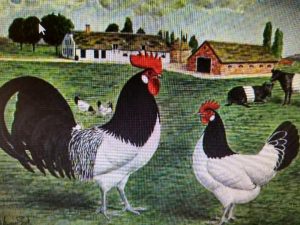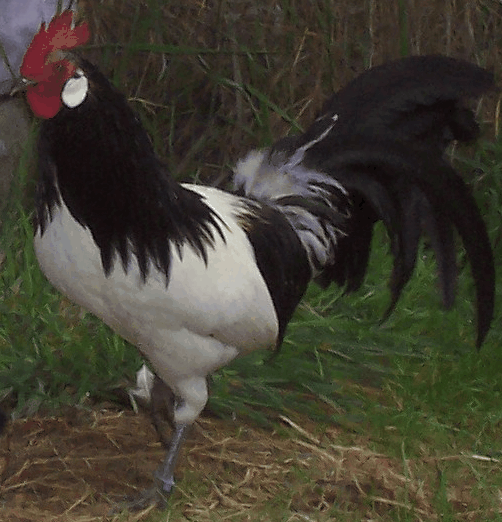
Breed Overview
History
Lakenvelder Chickens are an old established breed of early 18th Century German and Dutch origin. They are slightly built chickens with a slender curved body, carrying their tail high and known as good layers of small eggs.
Lakenvelder chickens first appeared in the 1700s around the border area between Holland and Germany. The name supposedly is derived from the Dutch village of Lakerveld in Utrecht. Similar looking chickens with a black neck, black tail and a white body naturally occurred as sports of the local German breed Westfalischer Totleger in the 1800s. These black and white sports were selectively bred by German breeders and shown competitively in the 1830s as Lakenvelders. Lakenvelder chickens were popular until the late 19th Century, when more productive breeds started to replace them and they declined in numbers. They are now considered a rare breed of chicken.
It can sometimes be difficult to currently buy chickens that combine the pure black neck hackle with sharply contrasting pure white body and the slate blue/grey under-color.
The hens usually have blue/gray colored down, are not noted for being good sitters, but rarely go broody.
Some people claim the name ‘Lakenvelder’ means ‘field of linen’ or ‘shadow on a sheet’, but it is actually the name of the black and white color patten. Lakenvelder cows also exist as a distinctive breed with similar black and white coloring. The Dutch used to say that Lakenvelder cows & chickens look as if a white sheet has been laid over the middle of their body. They are gorgeous however and no one questions that!
Lakenvelder Bantams
The Bantam has exactly the same looks and proportions as the large chicken, simply in a much smaller size. Like the standard size bird, Bantams prefer being outside foraging. If too closely confined Bantams will become bored and may start pecking each other.
Breed Hints & Tips
Lakenvelders prefer being outside foraging and can be flighty, nervy birds, making lots of noise if unhappy. Birds will happily stay out foraging for the whole day, from dawn to dusk, enjoy a diet of fallen fruit, insects, weeds and grubs. They are extremely agile, able to fly in one ‘hop’ over a 10 foot (3 metre) high fence with ease.
Lakenvelder roosters are protective of their hens and prefer to perch high up, so they can keep a good look-out for predators, such as hawks.
Lakenvelders are a lively chicken, available as standard and bantam sizes. They were first imported into the UK in the early 1900s and admitted to the American Poultry Asoociation in 1939.
Lakenvelder chickens are mostly kept free-range by backyard chicken enthusiasts, who value their looks and rate of egg production – does this sounds like the Lakenvelder is right for you?
As a rare ornamental breed Lakenvelder can be bought from a few breeders in both the USA and UK. There are now more Lakenvelder breeders emerging as interest in this breed builds. There is a particularly active club supporting Lakenvelder enthusiasts in Holland. The silver Lakenvelder is by far the most sought after.
Weight
Breed standards state that mature Standard males weigh up to 6 pounds (2.7 kg). Standard hens will typically weigh up to 4.5 pounds (2kg), mature Bantam hens around 1.5 pounds (.7 kg), and bantam cocks around 1.7 pounds (.8 kg).
Eggs
Size
Eggs are small size weighing around 1.7 ounces (50gms), with bantams laying eggs weighing 1 ounces (30 gms).
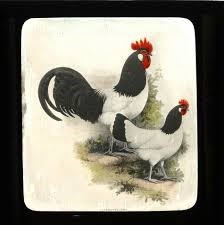
Color
Eggs are usually white or ivory
Production per year
Up to 160 eggs per year, for first four years.
When do they start laying eggs?
Chicks mature quickly and hens start laying from 6 months onwards.
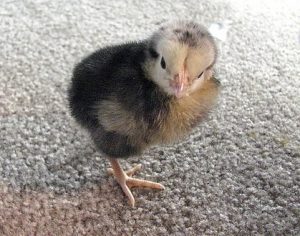
Lakenvelder Characteristics
Temperament / Are they good as pets?
Lakenvelder chickens can become pets if raised by hand as chicks. However, as these birds are naturally wary, they do not enjoy being handled. However, breeders often describe them as being noisy, flighty, standoffish and at times wild. These birds love to fly and explore, so high fencing is essential to contain them safely and pens need a wired top.
One cockerel for around 5 hens is a good ratio.
Lakenvelders have a good reputation as productive egg layers of small eggs, but require good quality feed daily. They love to actively forage outside ‘far and wide’ in warmer months and require large spaces for this.
How do I tame Lakenvelder chickens?
The best way to tame a chicken is to handle it gently when it is still young; this gets your chickens used to people. If you have older chickens that need taming, try feeding them out of your hand regularly. Lakenvelder chickens can become tame, but tend to generally ignore humans (unless offering food) and have a nervous, flighty nature. High containment fencing is necessary as these birds like nesting in trees. A good idea to train them to regularly return to the chicken coop each night, is to feed them before dusk regularly.
How many do I need to buy?
2 chickens are the absolute minimum you need for a flock, we recommend around 5 as a small flock number.
How much space do they need?
Lakenvelder ideally require a very large, secure backyard to do well. Standard birds are medium size and don’t like being confined in small chicken coops for long periods. Ideally 5 square feet minimum per mature bird in a coop and around 25 square feet minimum per bird in a run. Lakenvelder Chickens love being outside exploring and foraging for food, so must have good outside access to prevent boredom. These chickens are very good fliers, so high -level containment fencing is essential or you will see your chickens far away roosting in high trees or taken by predators!
Will they mix with my other chickens?
Lakenvelders are not aggressive birds, but are nervous and ‘flighty’, and not considered a good breed for a small backyard. Most breeders keep Lakenvelders as free range chickens requiring significant space to roam. They will get along well with other breeds of chickens, as long as there is no other male cockerel to cause aggressive behavior. It is vital the flock is not too closely confined and there is adequate room to explore and prevent boredom.
Appearance
The breed standard states that the head, neck hackle and tail of the Lakenvelder are solid black, without spots, ticks or stripes and the inner web of the wing primaries and secondaries is black. The rest of the bird is white with a pale blue-gray under-color. The black-and-white pattern is similar to the coloring of the Lakenvelder breed of cattle, which originated in the same area of Holland.
The eyes are bright chestnut or red, the beak dark horn color, and the face, wattles and serrated comb red, with white earlobes. The legs are slate-blue/gray. There is also a blue feathered variety that was imported into the UK from Holland. Females birds are unique in carrying their bright red comb erect, in a similar style to the male birds. Silver Lakenvelders chickens are currently the most popular color after, of course the standard white and black.
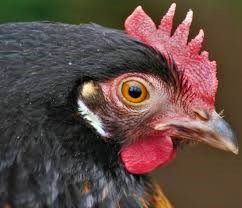
Lakenvelder possess a good set of powerful wings, which they frequently use to fly about at the slightest opportunity. The wing flight feathers should be clearly defined and the birds will happily fly up into high trees to roost, if allowed.
Plumage cover is good over the whole body, no skin is visible, providing the bird with reasonable cold weather insulation.
Feeding
What should I feed them?
When you first get your chickens home you should feed them growers mash, as it has a higher percentage of protein (19{cfcd481556a8b43fba6af451761032bd323e94372a0c1e607}) and is refined so that it can be easily ingested. You should feed them growers mash up until 6 weeks where they should be fed chicken pellets which is just feed in pellet form, this has between 15-16{cfcd481556a8b43fba6af451761032bd323e94372a0c1e607} protein. At 18 weeks your chickens need more nutrients to help with egg production so slowly start feeding them layers mash or pellets which has around 16{cfcd481556a8b43fba6af451761032bd323e94372a0c1e607} protein.
Chickens will need access to fresh drinking water all day long, they will prefer cool drinking water, no one is quite sure why maybe it’s a prehistoric throwback. It is important to have the feed and water at the proper height for all birds in the pen. Ideally feed and water should be at back level. If the water is too low down, chickens may scratch litter into it and the water will go bad quickly.
Your chickens also need grit to help with egg production. Make sure there is always some within easy access for them at all times. As Lakenvelder are excellent foragers they will supplement their feed intake by hunting outside. They’ll eat insects, slugs, snails, seeds and bugs to eat. A great breed, as will reduce your chicken feed bill!
How much should I feed them?
Lakenvelder are medium sized birds, and have healthy appetites, eating anywhere between 4 oz (113g) and 6 oz (170g) a day. On average breeders feed their chickens 5 oz (140g) a day. Start by feeding them this and then adjust the weight of feed around how much they consume. You can leave the feed in a feeder for them to eat whenever they please or you can give them set meal times.
Your chickens also need grit to help with egg production, so make sure there is always some in easy reach for them at all times.
What can’t they eat?
Chocolate and beans are the two main foods that shouldn’t be eaten by chickens. The phytohemagglutinin in beans can lead to fatalities and the theobromine in chocolate can cause heart problems. Moldy food that has bad bacteria in it should not be fed to chickens as it can make them very unwell. For this reason, it is illegal to feed your chickens leftovers in the UK.
What do I need to keep chickens?
The most essential item you need to keep chickens is a coop, which should ideally be 0.4 m2 or 5 square feet per chicken. Their run needs 25 square feet (2.3 m2) per chicken. In the coop they should have a perch to sleep on and a wooden laying box for their eggs.
You should invest in a sunken fence to go over and around the coop to keep them safe at night. Find a water bowl which they can’t stand in or push over and place it in the shade, so the water doesn’t get too warm. Feed and water for Lakenvelder are best placed off the ground, at around the ‘back’ height of the bird. Raised feed and water bowl holders are easily obtained.
